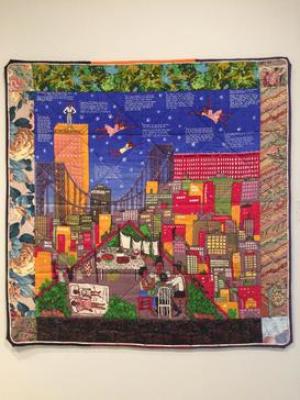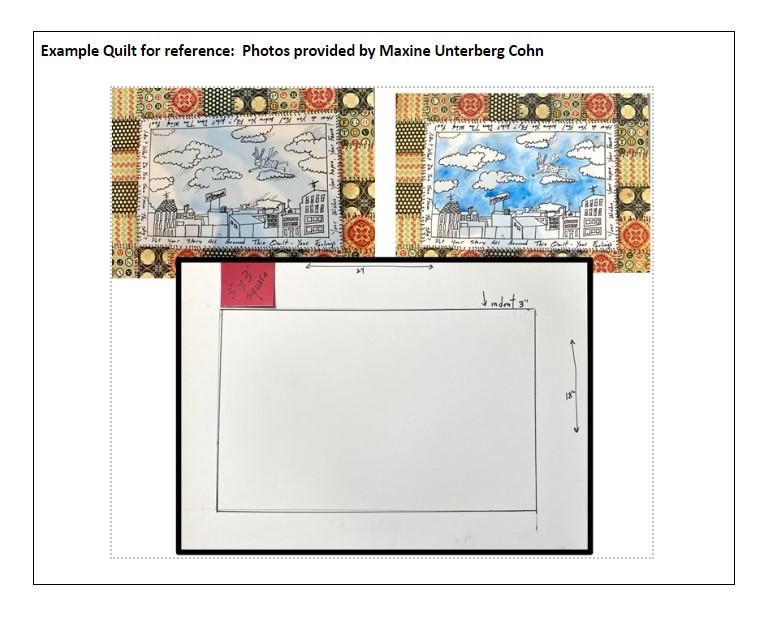Faith Ringgold And Her Fabulous Quilts

Students will have a chance to learn about Faith Ringgold’s autobiographical storytelling quilts and how they were influenced by her life. Students will then have the chance to make their own autobiographical, storytelling drawings with an optional second session to allow students to turn those drawings into mixed-media paper “quilts.”
Guiding Question:
How do our experiences shape the stories we tell?
at least two sessions of 45 minutes each
To introduce students to Faith Ringgold’s storytelling quilts and the concept of autobiographical art. Students will then get the chance to draw a picture or create a mixed-media quilt inspired by Ringgold’s work.
Students should know the term “autobiographical” and “quilt.” Teachers should familiarize themselves with Faith Ringgold’s biography (bullet points below) and work.
For option Session 2, the teacher should have colorful paper (such as scrap/patterned paper or a wallpaper book) cut into 3x3 squares. Students will use these squares to decorate the borders of their sketches from Session 1.
Materials:
- Paper for drawing
- Pens, markers, colored pencils or other art supplies for coloring
-
Computer
-
Projector for displaying video
-
YouTube video of Ringgold reading Tar Beach for NPR
-
A biography of Ringgold (options linked or bullet points below in instructions)
-
Erasers
Additional Materials for 2nd Session (Mixed-Media)
-
Scissors
-
Colored paper or other colorful/patterned scrap paper (such as a wallpaper book)
-
Glue
-
White paper
SESSION 1:
Warm Up:
The teacher should then lead the students in a 10 minute class discussion to get them thinking about the art project they will make later in the lesson. Sample questions of what to ask students include:
-
Have you ever dreamt of flying? If so, where did you fly?
-
Can you tell me a story about yourself?
-
How do you like to tell stories? Do you use funny voices, costumes, or props?
Activity 1: Biographical Background
Step 1: The Teacher should introduce the class to Faith Ringgold. Teachers can pull the biography from Ringgold’s website or the Guggenheim Museum or watch this roughly 9 minute video on Ringgold by the Fine Arts Museum of San Francisco.
Some important background information to include:
-
She was born in Harlem (a predominantly African American neighborhood in Manhattan), New York in 1930
-
She was in a family that emphasized the importance of education, travel, and what was going on in the world
-
Ringgold’s work stemmed from what she saw in her own community (autobiographical)
-
One quilt she made showed her friends and family having a picnic, another represented a trip to the roof of her apartment building during the summer, when it was hot, to get some cool air. This painting became known as “Tar Beach.” The name Tar Beach came from the inability to get to a real beach and the tar that was coated on the roofs thus, TAR BEACH! A perfect place to be outside and stay cool in the summer!
-
In the 1960s, she realized she was also an activist and began using her art as a form of activism, particularly promoting African American, female artists.
-
Her works are “narrative.” That is a word that simple means- to tell a story. Faith Ringgold always wanted to write her own autobiography (a book about herself) and tell her own stories, but she could not get someone to publish it. So, she decided to tell her own story by incorporating it into her artwork, particularly her “story quilts” (a form of her own making). She used quilts not only because of their historical connection to women’s work but also because it was practical (she could easily carry it).
-
You might be wondering “What is a quilt?”. A quilt is a combination of material from other projects that are pieced together to form a larger blanket. It tells a story in a way because it is a combination of many other sewing experiences.
-
Patterns are a large part of making quilts. Each piece has a different pattern and when combined with other patterns form an exciting visual experience.
-
Here’s a big word “Autobiographical.” Ringgold made autobiographical art. It means that much of Ringgold’s work was all about HER and HER experiences!!
Step 2: The teacher should then introduce students to “Tar Beach” by reading the following:
“In 1991, Faith Ringgold wrote “Tar Beach” to accompany her story quilt by the same name. It weaves together, fiction, autobiography, and African American history and literature. The story is about Cassie Louise Lightfoot, who is 8 years old, in the year 1939. Cassie has a dream: to be free to go wherever she wants for the rest of her life. One night, up on “tar beach” –the rooftop of her family’s Harlem apartment building–her dream comes true. The stars lift her up, and she flies over the city. She claims the buildings as her own–even the union building, so her father won’t have to worry anymore about not being allowed to join just because his father was not a member. As Cassie learns, anyone can fly. “All you need is somewhere to go you can’t get to any other way. The next thing you know, you’re flying above the stars.” (adapted from Faith Ringgold’s website)
Step 3: Teachers should then play the YouTube video (5 mins) of Ringgold reading her book, Tar Beach, on a central screen that all students can see. Teachers can ask the following questions after showing the video:
-
What do you notice about the border in Ringgold’s work?
-
Are the figures realistic (do they look real)? Are the figures rounded or flat?
-
Ringgold’s work is narrative, meaning it tells a story. How would you illustrate the narrative of your life?
-
Why do you think imagination is such an important factor when expressing your feelings?
Step 4: Teacher should then share this slide, which has Ringgold’s “Tar Beach” and Marc Chagall’s “Over the City” (1924). The teacher will tell the students that they are going to compare and contrast the two paintings. Teacher should lead a class discussion of 10-15 minutes using the below questions:
-
Teacher should first explain: “Marc Chagall was one of the most influential painters of the 20th century. He was born into a religious, Jewish family in the Russian Empire in 1887 (the area is now Belarus). He was a painter, designer, and printmaker, and often featured his hometown of Vitebsk and Jewish artistic traditions and figures in his art. He composed his images based on emotion and poetry rather than rules of logic, and many of his paintings include flying figures!”
-
What is similar about these two pieces of art?
-
Look at the settings of the pictures carefully. What is different about the two?
-
Ringgold’s is a “cityscape” (a view of a city”)
-
Chagall’s is a “landscape” (a picture representing a view of natural inland scenery)
-
-
What materials were used in each picture?
-
Chagall is a painting; Ringgold’s is a mixed-media quilt
-
-
Does Chagall tell a story in this painting? If so, what story do you think he is telling?
-
To note for the teacher: the “city” in this painting is Vitebsk, Chagall’s hometown. The two figures are widely considered to depict Chagall and his first wife, Bella.
-
This is a good question to get students to think about art as storytelling more generally, how they can be storytellers through their art, and letting students know that Ringgold was part of a tradition or storytelling through art.
-
Both Ringgold and Chagall told stories about marginalized groups—Chagall and Jewish subjects and Ringgold and African Americans, especially women
-
Activity 2: Sketching
Students will then turn to the art-creation section of the lesson. Students should each receive a piece of paper, pencil, and eraser for sketching. Tell students that they will become “visual storytellers” by sketching their own picture of themselves in flight as inspired by Tar Beach. After the drawing utensils have been handed out, the teacher should ask the students:
-
What would your body look like if you were flying? (This question could prompt students to either describe or model what their bodies would look like in flight)
-
Can you create a piece of art that combines places that you love, your family, and/or your community?
The teacher can then explain that sketching is something “you do light until you get it right” (I.e. it doesn’t need to be perfect). This can eliminate the students’ desire to erase a lot. Remind the students to leave a border so they can add words to their drawings!
Give the students 15-20 minutes to sketch themselves flying over their favorite place. They should also write a list of words to describe their sketch and their inspiration. If doing Session 2: have the students keep this list separate as they will add the words later. If NOT doing Session 2: have the students write their list of words in the border of their sketch.
If teacher plans to do Session 2: teacher should collect the students’ sketches and save them for Session 2.
SESSION 2 (Optional)
Prerequisites
Teacher should have colorful paper (such as scrap/patterned paper or a wallpaper book) cut into 3x3 squares. Students will use these squares to decorate the borders of their sketches from Session 1.
Warm Up:
Teacher should begin by asking students to recap what they learned in the first session. Questions to include in this 7-10 minute discussion could include:
-
Who was Faith Ringgold? What was her favorite way of expressing herself?
-
What kind of art did Ringgold create and what were her influences?
-
What is autobiography? What is autobiographical art?
-
What is visual storytelling?
Activity: Quilt Making
Teacher should hand back the flying sketches from Session 1 to each student. Tell the students they will be turning these drawings into mixed-media “quilts” inspired by the work of Faith Ringgold. Teachers can either hand out scraps of cut-up colored paper, glue sticks, and markers to each student or can make stations for each of these materials. The following steps should be taken.
-
Students should choose their colored-paper squares and begin to clue the squares around the border of their sketches
-
When the students have completed their “frame,” they can then begin coloring their sketches. This can be done with markers, colored pencils, water colors, or other coloring utensils
-
When students have finished painting their drawings, have them use markers or Sharpies to create the “stitches” between the squares
-
Finally, students should add their descriptive words from Session 1 to their painting by adding them to the border in marker, paint, or colored pencil.
Once the students have completed their drawings, leave 10-15 minutes for students to share their story-telling quilts with the class! Each student should present their painting, explain the words they chose for the border, and why they chose to create it.

- Have students reflect on their quilt and Ringgold by answering the following question either through class discussion or as a written assignment:
- What is something you learned about Faith Ringgold through her visual storytelling?
- What is something you hope people learn about you in your visual storytelling?
-
English teachers may ask students to either come up with a list or write a paragraph describing where they would fly, what they would look like while flying, and their inspiration as a stand-alone assignment.
-
Math teachers can use the cutting of scrap paper into 3x3 squares as a ruler and measuring lesson.
D2.His.6.3-5. Describe how people’s perspectives shaped the historical sources they created.
